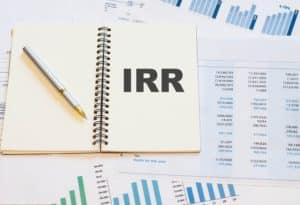Commercial real estate investing is a game of numbers. Investors spend hours poring over financial data, vacancy rates, ROI, and more. Unlike traditional stock market investments, commercial real estate investments are private assets, so the numbers are somewhat harder to find—and novice investors may not know where to begin.
Yet evaluating and assessing metrics is crucial for success in IRR commercial real estate investing—for both general and limited partners. This IRR guide for commercial real estate investors will support you in leveraging one of the most critical metrics for your business: your internal rate of return.
What Is IRR?
The internal rate of return (IRR) is one of several financial metrics that project an investor’s return on investment (ROI) by accounting for the time value of money. Investors typically calculate IRR while conducting discounted cash flow (DCF) analyzes before purchasing a property. DCF is a method used to calculate the estimated value of an investment based on projected cash flow. IRR differs from other relevant metrics in that it represents the annual return of an investment relative to the “break-even” point.
IRR calculations are thus crucial in determining the rate of yearly return at which the net present value (NPV) equals zero. Investors often compare this number to their company’s hurdle rate: the required rate of return as per company standards. The higher the internal rate of return, the more valuable the investment.
Why Use IRR
Calculating your IRR will allow you to determine the future annual profitability of an investment and make sound decisions based on our findings. Because the IRR is expressed as a rate, it delineates the threshold of value required for an investment.
A higher IRR typically translates to a profitable investment, but the number is relative to the cost of capital initially invested in the project. Therefore, a good IRR is generally higher than a given hurdle rate. Investors often use IRR to present their projects to potential investors since IRR is more intuitive and easier to understand.
How to Calculate IRR

There are several ways to understand an IRR calculation. First, consider the IRR formulas below. Then, read through the steps for calculating IRR.
Formula for Calculating IRR
Few investors use the IRR formula to conduct their calculations because formulas can only generate broad estimates. Typically, IRR commercial real estate investors use an online calculator or spreadsheet to tabulate the numbers. However, the IRR formula is worth examining for comprehension. One formula is:
0= NPV = t=1T Ct(1+IRR)t – C0
Where:
- T = number of periods
- Ct= Net cash flow during period t
- IRR = Internal rate of return
- C0 = total investment costs
Alternatively, some investors use the following IRR formula:
NPV=t=0∑n(1+r)tCFt
There are other additional formulas you can use to calculate IRR, but the above are the most common standard equations. Remember that setting the NPV to zero is crucial in accurately predicting IRR.
Calculating IRR With a Financial Calculator
Most commercial real estate investors use investor management platforms or financial calculators to determine IRR. Many platforms feature automated systems that calculate important metrics for you and deliver results in easy-to-read reports and graphics.
You can also use a financial calculator to determine your IRR. You can easily locate a comprehensive calculator with a quick Google search. If possible, use a real-estate-specific IRR calculator that generates accessible reports.
Calculating IRR With Spreadsheets
Many investors rely on spreadsheets like those available in Excel or Google Sheets. There are two methods for calculating IRR in Excel:
- Use a built-in IRR formula
- Calculate each step individually by breaking out component cash flows.
The first method is easier, while the second generates more transparent results and promotes visibility and trust among commercial real estate investors involved in the transaction.
IRR in Commercial Real Estate
There are many reasons to compute IRR when investing in commercial real estate. First, determining IRR can allow you to determine whether you wish to make the initial investment. Second, IRR is a clear and comprehensive metric that you can use to present your ideas to additional investors and partners.
Undertaking an IRR analysis is also crucial to profit in commercial real estate during inflation because it allows you to account for inflation rates while generating a reliable predictor of growth.
How to Calculate IRR for Commercial Real Estate
To calculate your IRR for a commercial real estate investment, you need to draw up estimates for several variables, including your annual investor distributions, the date you plan to sell the project, and your estimated sale price. Then, you can use these variables to determine IRR.
Example
Consider the following example of an IRR calculation. You are calculating the IRR of a five-year investment with yearly distributions:
- Assume an initial investment of $1,000
- Assume yearly distributions of $100
- Assume you recover your investment of $1,000 upon selling the project.
- Plug these numbers into the above equation or use an alternative method.
From this example, the IRR amounts to 10%. This means that your annualized rate of profit on the good investment is 10%.
Benefits of Using IRR in Commercial Real Estate Investing
IRR leverages certain metrics that ROI does not, so it can be instrumental in generating more specific data. Including the time value of money allows investors to estimate their potential losses relative to returns better.
While IRR may take longer to calculate, it allows investors to make targeted decisions between select properties. If you are choosing between several investment opportunities, you can use IRR to make a more informed choice than if you were simply using ROI.
IRR is useful to commercial real estate investors because it considers the more specific, complex variables involved in property investments.
Investors can use IRR to determine the profitability of pre-owned assets, predict the profitability of a potential asset, or compare various existing and possible assets.
Drawbacks to Using IRR in Commercial Real Estate Investing
Although IRR is a useful calculation for commercial real estate investors, no metric is perfect, and expert real estate investors typically use multiple metrics to evaluate an asset.
Calculating IRR is not time-efficient, and it requires identifying each variable before computing them. Therefore, most investors do not use IRR when selecting from a vast pool of investment opportunities.
Additionally, several variables in the IRR equation are impossible to identify objectively.
Although IRR identifies potential returns, there are no certainties in commercial real estate investing. Unexpected events, such as economic downturns and undisclosed damages, can offset expected profits.
Lastly, IRR is a comparative metric, meaning it is most informative when combined with other metrics and compared to the IRRs of other investments.
Other Metrics to Consider
Calculating IRR can only provide so much insight into the nature of an investment. While IRR is an informative metric, a thorough evaluation of your asset requires considering additional metrics.
IRR vs. Net Present Value (NPV)
IRR and NPV are closely related as they both estimate the growth of an investment. Net present value, however, is the difference between the present value of cash inflows and outflows over a set period. IRR is a more complex formula that uses NPV to estimate future profitability more precisely.
IRR vs. Compound Annual Growth (CAG)
IRR and CAG are measures of annual growth on investment. IRR, however, is also a rate of return and reflects the many cash inflows and outflows that comprise a long-term investment.
IRR vs. Return on Investment (ROI)
Although IRR and ROI are similar, they feature several important distinctions. First, ROI is more widely used because it is easier to calculate and can allow investors to make snap judgments. Additionally, ROI and IRR are typically similar numbers over the course of the first year of the investment period.
Investors use ROI to determine the overall growth of an investment over time. IRR, however, identifies the annual growth rate of an investment. Investors calculate ROI by identifying the difference between the current value of a project and the original value, dividing by the original value, and multiplying by 100. Therefore, ROI reflects existing financial metrics, while IRR projects values into the future.
Additional Metrics
When evaluating a property investment, ensure that you examine additional commercial real estate metrics. Common metrics to consider include:
- Local vacancy rate
- Operating Expenses (OER)
- Gross Rent Multiplier (GRM)
- Inflation rates
Make the Most of Your Investments

The internal rate of return is one of the most important metrics in commercial real estate investing. This number can provide insight into how profitable your investment is likely to be. It can also help new investors navigate the playing field with the help of a general partner and can prove useful in facilitating lucrative partnerships. Remember to use IRR in conjunction with other insightful metrics, and keep in mind that IRR is an estimate subject to change. Managing limited partnerships with a transparent, accessible platform can help you to make the most of your investments. Contact EXtrance today to learn how we can help you maximize your commercial real estate investments.

